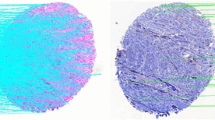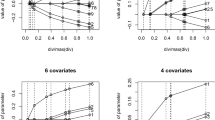Abstract
For fitting curves or surfaces to observed or measured data, a common criterion is orthogonal distance regression. We consider here a natural generalization of a particular formulation of that problem which involves the replacement of least squares by the Chebyshev norm. For example, this criterion may be a more appropriate one in the context of accept/reject decisions for manufactured parts. The resulting problem has some interesting features: it has much structure which can be exploited, but generally the solution is not unique. We consider a method of Gauss-Newton type and show that if the non-uniqueness is resolved in a way which is consistent with a particular way of exploiting the structure in the linear subproblem, this can not only allow the method to be properly defined, but can permit a second order rate of convergence. Numerical examples are given to illustrate this.
Similar content being viewed by others
References
A. Atieg and G. A. Watson, A class of methods for fitting a curve or surface to data by minimizing the sum of squares of orthogonal distances, J. Comput. Appl. Math., 158 (2003), pp. 277–296.
A. Atieg and G. A. Watson, Use ofl p norms in fitting curves and surfaces to data, Aust. N. Z. Ind. Appl. Math. J., 45 (E) (2004), pp. C187–C200.
S. J. Ahn, W. Rauh, and H.-J. Warnecke, Least-squares orthogonal distances fitting of circle, sphere, ellipse, hyperbola, and parabola, Pattern Recognition, 34 (2001), pp. 2283–2303.
S. J. Ahn, E. Westkämper, and W. Rauh, Orthogonal distance fitting of parametric curves and surfaces, in J. Levesley, I. J. Anderson, and J. C. Mason (eds.), Algorithms for Approximation IV, University of Huddersfield, 2002, pp. 122–129.
M. Berman, Estimating the parameters of a circle when angular differences are known, Appl. Stat., 32 (1983), pp. 1–6.
M. Gulliksson, I. Söderkvist, and G. A. Watson, Implicit surface fitting using directional constraints, BIT, 41 (2001), pp. 331–344.
P. T. Boggs, R. H. Byrd, and R. B. Schnabel, A stable and efficient algorithm for nonlinear orthogonal distance regression, SIAM J. Sci. Stat. Comput., 8 (1987), pp. 1052–1078.
G. Hadley, Linear Programming, Addison-Wesley, Reading, Mass., 1962.
H.-P. Helfrich and D. Zwick, A trust region algorithm for parametric curve and surface fitting, J. Comput. Appl. Math., 73 (1996), pp. 119–134.
H.-P. Helfrich and D. Zwick, l1andl∞fitting of geometric elements, in J. Levesley, I. J. Anderson, and J. C. Mason (eds.), Algorithms for Approximation IV, University of Huddersfield, 2002, pp. 122–129.
J. R. Rice, Tchebycheff approximation in a compact metric space, Bull. Am. Math. Soc., 68 (1962), pp. 405–410.
C. Ross, I. J. Anderson, J. C. Mason, and D. A. Turner, Approximating coordinate data that has outliers, in P. Ciarlini, A. B. Forbes, F. Pavese and D. Richter (eds.), Advanced Mathematical and Computational Tools in Metrology IV, Series on Advances in Mathematics for Applied Sciences, Volume 53, World Scientific, Singapore, 2000, pp. 210–219.
H. Späth, Estimating the parameters of an ellipse when angular differences are known, Comput. Stat., 14 (1999), pp. 491–500.
H. Späth, Least squares fitting of spheres and ellipsoids using not orthogonal distances, Math. Commun., 6 (2001), pp. 89–96.
R. Strebel, D. Sourlier, and W. Gander, A comparison of orthogonal least squares fitting in coordinate metrology, in S. Van Huffel (ed.), Recent Advances in Total Least Squares and Errors-in-Variables Techniques, SIAM, Philadelphia, 1997, pp. 249–258.
D. A. Turner, The Approximation of Cartesian Co-ordinate Data by Parametric Orthogonal Distance Regression, PhD Thesis, University of Huddersfield, 1999.
D. A. Turner, I. J. Anderson, J. C. Mason, M. G. Cox, and A. B. Forbes, An efficient separation-of-variables approach to parametric orthogonal distance regression, in P. Ciarlini, A. B. Forbes, F. Pavese, and D. Richter (eds.), Advanced Mathematical and Computational Tools in Metrology IV, Series on Advances in Mathematics for Applied Sciences, Volume 53, World Scientific, Singapore, 2000, pp. 246–255.
G. A. Watson, Approximation Theory and Numerical Methods, Wiley, 1980.
G. A. Watson, Least squares fitting of circles and ellipses to measured data, BIT, 39 (1999), pp. 176–191.
G. A. Watson, Some problems in orthogonal and non-orthogonal distance regression, in J. Levesley, I. J. Anderson, and J. C. Mason (eds.), Algorithms for Approximation IV, University of Huddersfield, 2002, pp. 294–302.
G. A. Watson, On the Gauss-Newton method forl1orthogonal distance regression, IMA J. Numer. Anal., 22 (2002), pp. 345–357.
G. A. Watson, Incorporating angular information into parametric models, BIT, 42 (2002), pp. 867–878.
G. A. Watson and C. Yiu, On the solution of the errors in variables problem using thel1norm, BIT, 31 (1991), pp. 697–710.
D. S. Zwick, Applications of orthogonal distance regression in metrology, in S. Van Huffel (ed.), Recent Advances in Total Least Squares and Errors-in-Variables Techniques, SIAM, Philadelphia, 1997, pp. 265–272.
Author information
Authors and Affiliations
Corresponding authors
Additional information
AMS subject classification (2000)
65D10, 65K05
Rights and permissions
About this article
Cite this article
Al-Subaihi, I., Watson, G. Fitting Parametric Curves and Surfaces by l∞ Distance Regression. Bit Numer Math 45, 443–461 (2005). https://doi.org/10.1007/s10543-005-0018-z
Issue Date:
DOI: https://doi.org/10.1007/s10543-005-0018-z




